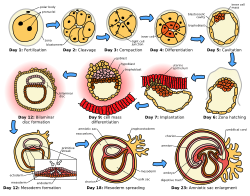| Implantation | |
|---|---|
 Implantation as one of the early stages of human embryonic development | |
| Details | |
| Carnegie stage | 3 |
| Days | 5–9 |
| Gives rise to | Gastrula |
| Identifiers | |
| MeSH | D010064 |
| Anatomical terminology | |
Implantation, also known as nidation,[1] is the stage in the mammalian embryonic development in which the blastocyst hatches, attaches, adheres, and invades into the endometrium of the female's uterus.[2] Implantation is the first stage of gestation, and, when successful, the female is considered to be pregnant.[3] An implanted embryo is detected by the presence of increased levels of human chorionic gonadotropin (hCG) in a pregnancy test.[3] The implanted embryo will receive oxygen and nutrients in order to grow.
For implantation to take place the uterus must become receptive. Uterine receptivity involves much cross-talk between the embryo and the uterus, initiating changes to the endometrium. This stage gives a synchrony that opens a window of implantation that enables successful implantation of a viable embryo.[4] The endocannabinoid system plays a vital role in this synchrony in the uterus, influencing uterine receptivity, and embryo implantation.[5] The embryo expresses cannabinoid receptors early in its development that are responsive to anandamide (AEA) secreted in the uterus. AEA is produced at higher levels before implantation and is then down-regulated at the time of implantation. This signaling is of importance in the embryo-uterus crosstalk in regulating the timing of embryonic implantation and uterine receptivity. Adequate concentrations of AEA that are neither too high or too low, are needed for successful implantation.[5][6][7]
There is an extensive variation in the type of trophoblast cells, and structures of the placenta across the different species of mammals.[8] Of the five recognised stages of implantation including two pre-implantation stages that precede placentation, the first four are similar across the species. The five stages are migration and hatching, pre-contact, attachment, adhesion, and invasion.[8] The two pre-implantation stages are associated with the pre-implantation embryo.[9][10]
In humans, following the stage of hatching that takes place around four to five days after fertilization, the process of implantation begins. By the end of the first week, the blastocyst is superficially attached to the uterine endometrium. By the end of the second week, implantation has completed.[11]
- ^ "Definition of implantation". www.merriam-webster.com. Retrieved 26 April 2023.
- ^ Niringiyumukiza JD, Cai H, Xiang W (May 2018). "Prostaglandin E2 involvement in mammalian female fertility: ovulation, fertilization, embryo development and early implantation". Reproductive Biology and Endocrinology. 16 (1): 43. doi:10.1186/s12958-018-0359-5. PMC 5928575. PMID 29716588.
- ^ a b Wilcox AJ, Harmon Q, Doody K, Wolf DP, Adashi EY (April 2020). "Preimplantation loss of fertilized human ova: estimating the unobservable". Human Reproduction. 35 (4): 743–750. doi:10.1093/humrep/deaa048. PMC 8287936. PMID 32296829.
- ^ Cite error: The named reference
Yangwas invoked but never defined (see the help page). - ^ a b Ezechukwu HC, Diya CA, Shrestha N, Hryciw DH (September 2020). "Role for endocannabinoids in early pregnancy: recent advances and the effects of cannabis use". American Journal of Physiology. Endocrinology and Metabolism. 319 (3): E557–E561. doi:10.1152/ajpendo.00210.2020. PMID 32744098. S2CID 220943305.
- ^ Maccarrone M, Valensise H, Bari M, Lazzarin N, Romanini C, Finazzi-Agrò A (2000). "Relation between decreased anandamide hydrolase concentrations in human lymphocytes and miscarriage". Lancet. 355 (9212): 1326–9. doi:10.1016/S0140-6736(00)02115-2. PMID 10776746. S2CID 39733100.
- ^ Dennedy MC, Friel AM, Houlihan DD, Broderick VM, Smith T, Morrison JJ (January 2004). "Cannabinoids and the human uterus during pregnancy" (PDF). American Journal of Obstetrics and Gynecology. 190 (1): 2–9, discussion 3A. doi:10.1016/j.ajog.2003.07.013. PMID 14749627.
- ^ a b Imakawa K, Bai R, Fujiwara H, Kusama K (January 2016). "Conceptus implantation and placentation: molecules related to epithelial-mesenchymal transition, lymphocyte homing, endogenous retroviruses, and exosomes". Reproductive Medicine and Biology. 15 (1): 1–11. doi:10.1007/s12522-015-0215-7. PMC 5715838. PMID 29259417.
- ^ Cite error: The named reference
Kimwas invoked but never defined (see the help page). - ^ McGowen MR, Erez O, Romero R, Wildman DE (2014). "The evolution of embryo implantation". The International Journal of Developmental Biology. 58 (2–4): 155–161. doi:10.1387/ijdb.140020dw. PMC 6053685. PMID 25023681.
- ^ Moore KL (2020). The developing human: clinically oriented embryology (Eleventh ed.). Edinburgh. pp. 35–42. ISBN 978-0-323-61154-1.
{{cite book}}: CS1 maint: location missing publisher (link)